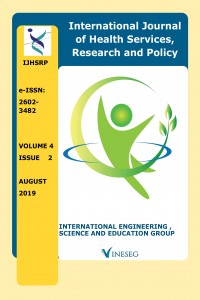Abstract
Project Number
13-TF-158
References
- [1] Chang MDY, Pollard JW, et al. Mouse placental macrophages have a decreased ability to present antigen. Proceedings of the National Academy of Sciences, 90, 462-466, 1993.
- [2] Bulmer JN, Johnson PM. Macrophage populations in the human placenta and amniochorion. Clinical Experimental Immunology, 57, 393-403, 1984.
- [3] Mues B, Langer D, et al. Phenotypic Characterization of Macrophages in Human Term Placenta. Immunology, 67, 303-307, 1989.
- [4] Sonnenberg A, Linders CJ, et al. The alpha 6 beta 1 (VLA-6) and alpha 6 beta 4 protein complexes: tissue distribution and biochemical properties. J Cell Sci, 96, 207–217, 1990.
- [5] Moore KL. The developing human. 3rd ed; Philadelphia; WB Saunders,6, 111-118, 1983.
- [6] Laga EM, Dirscoll SG,et al . Quantitative studies of human placenta. Biol Neonate, 23, 260-83, 1993.
- [7] Teasudale F. Gestational changes in the function structure of human placenta in relation to fetal growth. Am J Obstet Gynec,137, 560-568, 1980.
- [8] Winick M, Coscia A, et al. Cellular growth in normal placenta. Pediatr, 39:248-51,1987.
- [9] Kumar V, Cotran S, et al. Basic pathology, 6th ed; Pennsylvania; WB Saunders, 3, 1082-1084, 2000.
- [10] Feczko JD, Kluber KM. Cytoarchitecture of muscle in genetic model of murine diabetes. Am J Anat ,182, 224-240, 1988.
- [11] Salvatore AC. The placenta in acute toxemia. Am J Obstet. Gynecol,102, 347-353, 1968.
- [12] Honda M, Toyoda C, et al. Quantitative investigations of placental terminal villi in maternal diabetes mellitus by scanning and transmission electron microscopy. Tohoku J Exp Med, 167, 247–257, 1992.
- [13] Benirschke K, Kaufmann P, Baergen RN. Pathology of the human placenta. 6th ed. Berlin-Germany, 150-155, 2006.
- [14] Gewolb I, Merdian W, et al. Fine structural abnormalities of the placenta in diabetic rats. Diabetes,35, 254–261,1986.
- [15] Pietryga M, Biczysko W, et al. Ultrastructural examination of the placenta in pregnancy complicated by diabetes mellitus. Ginekol Pol, 75,111–8, 2004.
HISTOLOGICAL OF CHANGES IN THE AMNIOTIC MEMBRANE AND PLACENTAL VILLOUS BASAL LAMINA IN COMPLICATED PREGNANCIES
Abstract
Aim: This study aimed to histological changes compare placental
villous basal lamina and amniotic membrane changes in complicated pregnancy.
Methods: Studies
were performed on the human placentas, delivered between 24-39 weeks of
gestation. Patients were separated equally into 4 groups (Control, preeclampsia (PE),
gestastional diabetes (GD), and HELLP syndrome groups)
Placental
tissue samples were dissected and fixed in 10% neutral formalin buffer. Routine
paraffin tissue protocol was followed. Some of sections were stained with
Periodic Acid Schiff. Remaining sections were stained with integrin alpha-6
antibody.To define expression percentage, mean of the staining area/total
staining area ratio were calculated. The statistical significance of the
expression percentages was compared by One Way ANOVA and Tukey tests with SPSS
Statistics V24 software.
Results: In PAS-stained preeclamptic, HELLP and gestational
diabetes groups placental villous basal lamina and vasculo-syncytial membranes were thicker than the
control group. A significant difference was observed in all 3 groups compared
to the control group the placental villous basal lamina
thickness of the HELLP group
was found to be significantly different from all three groups. In chorionic
villi of HELLP group, dense integrin expression was found in placental villous basal lamina similar to that in GD and preeclampsia groups. The HELLP group was
significantly different from all groups.
Conclusion: In preeclampsia, gestational diabetes and HELLP
placentas, placental viiöz basal lamina and amniotic membrane significantly thickened and
structural changes were observed.
Supporting Institution
Dicle University
Project Number
13-TF-158
References
- [1] Chang MDY, Pollard JW, et al. Mouse placental macrophages have a decreased ability to present antigen. Proceedings of the National Academy of Sciences, 90, 462-466, 1993.
- [2] Bulmer JN, Johnson PM. Macrophage populations in the human placenta and amniochorion. Clinical Experimental Immunology, 57, 393-403, 1984.
- [3] Mues B, Langer D, et al. Phenotypic Characterization of Macrophages in Human Term Placenta. Immunology, 67, 303-307, 1989.
- [4] Sonnenberg A, Linders CJ, et al. The alpha 6 beta 1 (VLA-6) and alpha 6 beta 4 protein complexes: tissue distribution and biochemical properties. J Cell Sci, 96, 207–217, 1990.
- [5] Moore KL. The developing human. 3rd ed; Philadelphia; WB Saunders,6, 111-118, 1983.
- [6] Laga EM, Dirscoll SG,et al . Quantitative studies of human placenta. Biol Neonate, 23, 260-83, 1993.
- [7] Teasudale F. Gestational changes in the function structure of human placenta in relation to fetal growth. Am J Obstet Gynec,137, 560-568, 1980.
- [8] Winick M, Coscia A, et al. Cellular growth in normal placenta. Pediatr, 39:248-51,1987.
- [9] Kumar V, Cotran S, et al. Basic pathology, 6th ed; Pennsylvania; WB Saunders, 3, 1082-1084, 2000.
- [10] Feczko JD, Kluber KM. Cytoarchitecture of muscle in genetic model of murine diabetes. Am J Anat ,182, 224-240, 1988.
- [11] Salvatore AC. The placenta in acute toxemia. Am J Obstet. Gynecol,102, 347-353, 1968.
- [12] Honda M, Toyoda C, et al. Quantitative investigations of placental terminal villi in maternal diabetes mellitus by scanning and transmission electron microscopy. Tohoku J Exp Med, 167, 247–257, 1992.
- [13] Benirschke K, Kaufmann P, Baergen RN. Pathology of the human placenta. 6th ed. Berlin-Germany, 150-155, 2006.
- [14] Gewolb I, Merdian W, et al. Fine structural abnormalities of the placenta in diabetic rats. Diabetes,35, 254–261,1986.
- [15] Pietryga M, Biczysko W, et al. Ultrastructural examination of the placenta in pregnancy complicated by diabetes mellitus. Ginekol Pol, 75,111–8, 2004.
Details
| Primary Language | English |
|---|---|
| Subjects | Evolutionary Biology (Other) |
| Journal Section | Article |
| Authors | |
| Project Number | 13-TF-158 |
| Publication Date | August 27, 2019 |
| Submission Date | July 3, 2019 |
| Acceptance Date | July 22, 2019 |
| Published in Issue | Year 2019 Volume: 4 Issue: 2 |








